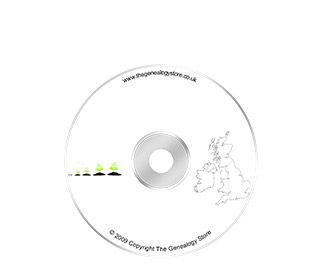Categories
Australia Data Cd's-> (20)
Family Histories & Genealogies (11)
Genealogy Mugs (3)
Germany Data CD's-> (13)
Heraldry Data CD's (25)
Military Data CD's-> (30)
Russia Data CD's-> (6)
Digital Downloads-> (1698)
England Data CD's-> (1349)
Bedfordshire (11)
Berkshire (30)
Buckinghamshire (38)
Cambridgeshire (32)
Cheshire (22)
Cornwall (15)
Cumberland (19)
Derbyshire (11)
Devonshire (36)
Dorset (40)
Durham (17)
England / Great Britain (9)
Essex (22)
Gloucestershire (24)
Hampshire (37)
Herefordshire (23)
Hertfordshire (11)
Huntingdonshire (7)
Isle Of Man (1)
Kent (74)
Lancashire (110)
Leicestershire (20)
Lincolnshire (27)
London (104)
Medical-> (11)
Merchants/Trades (2)
Middlesex (17)
Military-> (7)
Non Conformist Registers (1)
Norfolk (27)
Northamptonshire (12)
Northumberland (18)
Nottinghamshire (19)
Oxfordshire (14)
Religion-> (13)
Rutland (1)
Shropshire (56)
Somerset (37)
Staffordshire (33)
Suffolk (27)
Surrey (33)
Sussex (37)
Warwickshire (34)
Westmorland (12)
Wiltshire (23)
Worcestershire (16)
Yorkshire (159)
Ireland Data CD's-> (22)
Scotland Data CD's-> (100)
Wales Data CD's-> (18)
USA Data CD's-> (174)
Canada Data CD's-> (71)
Family Histories & Genealogies (11)
Genealogy Mugs (3)
Germany Data CD's-> (13)
Heraldry Data CD's (25)
Military Data CD's-> (30)
Russia Data CD's-> (6)
Digital Downloads-> (1698)
England Data CD's-> (1349)
Bedfordshire (11)
Berkshire (30)
Buckinghamshire (38)
Cambridgeshire (32)
Cheshire (22)
Cornwall (15)
Cumberland (19)
Derbyshire (11)
Devonshire (36)
Dorset (40)
Durham (17)
England / Great Britain (9)
Essex (22)
Gloucestershire (24)
Hampshire (37)
Herefordshire (23)
Hertfordshire (11)
Huntingdonshire (7)
Isle Of Man (1)
Kent (74)
Lancashire (110)
Leicestershire (20)
Lincolnshire (27)
London (104)
Medical-> (11)
Merchants/Trades (2)
Middlesex (17)
Military-> (7)
Non Conformist Registers (1)
Norfolk (27)
Northamptonshire (12)
Northumberland (18)
Nottinghamshire (19)
Oxfordshire (14)
Religion-> (13)
Rutland (1)
Shropshire (56)
Somerset (37)
Staffordshire (33)
Suffolk (27)
Surrey (33)
Sussex (37)
Warwickshire (34)
Westmorland (12)
Wiltshire (23)
Worcestershire (16)
Yorkshire (159)
Ireland Data CD's-> (22)
Scotland Data CD's-> (100)
Wales Data CD's-> (18)
USA Data CD's-> (174)
Canada Data CD's-> (71)
Manufacturers
Copyright © 2024 The Genealogy Store
Powered by osCommerce








